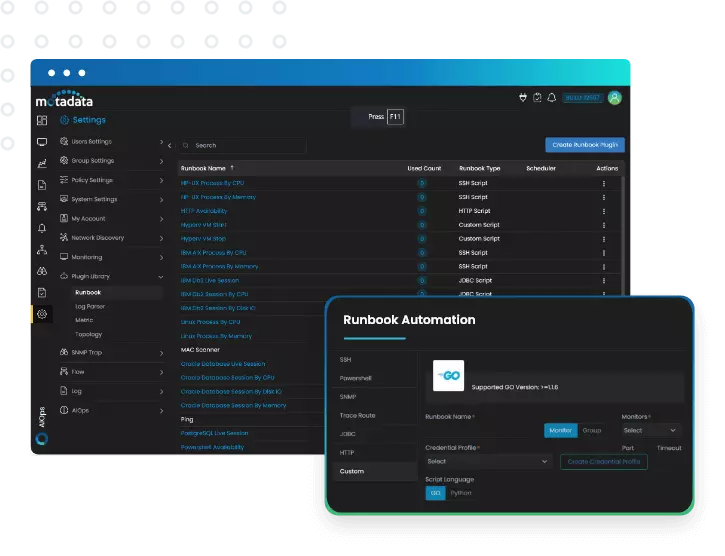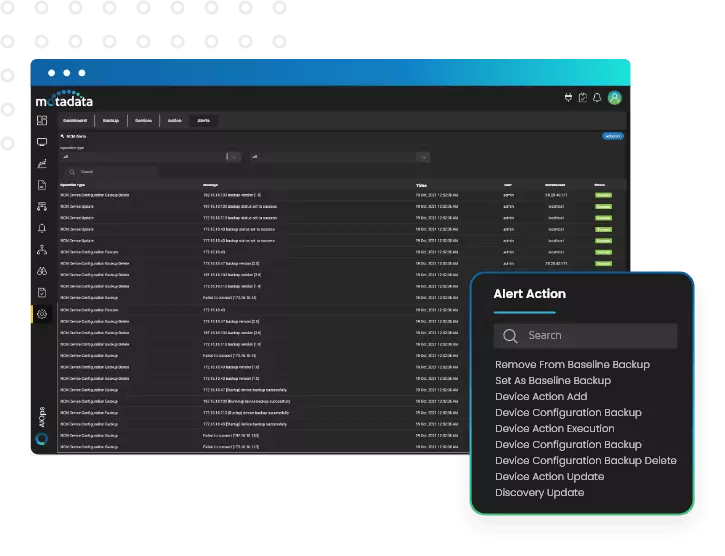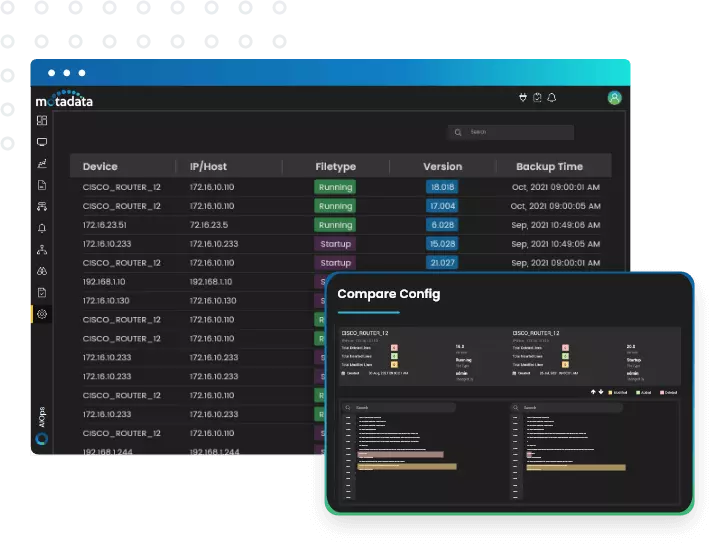Reliable, Secure, and Automated
Network Configuration Management
Visualize Recent and Failed Backups, Device Distribution, Failure Trends, and much more on One Unified Platform. Execute Dashboard Reports by Exporting Dashboard Insights into PDF/CSV Files.

AI-Driven Network Automation
configuration management to deploy configurations, reports, detect out-of-process changes, audits and backups.
- AI-Driven Configuration: Configure your network with AI-Driven Network Automation, making your network smarter and healthier than ever.
- Automated Configuration for Change, Backup & Restore: Simplify recurring complex configuration changes instead of manually executing multiple devices.
- Advanced Remediation with Runbook: The python integration makes Runbook remediation advanced and empowering with monitoring and troubleshooting capacities.

An Intelligent Alert System
Stay alert all the time with a smart alert system. Stay one step ahead and resolve the problems even before they cause any damage.
- Change Monitoring & Management: Stay up to date on configuration changes with alerts and view the changes made. Leverage role-based access for complete control on who can make changes to devices & configurations.
- Audit: Configure the audit logs and get powerful actionable insights with audit reports.
- Notification: The tool notifies whenever there is a change in the device configuration, thereby helping you quickly replace a failed element.

More Security than Ever
Locate a backup file quickly in need of the hour by simplifying processes like highlighting configuration errors, scheduling regular backups, & archives executing scripts.
- Network Security & Compliance: Improve overall network security by easily identifying vulnerabilities with a vulnerability assessment. Assess and enforce compliance with critical security standards using OOB reports for FISMA, PCI DSS, etc.
- Seamless Integration: Pre-integrated support for well-known network device vendors like Cisco, HP, Juniper, D-Link, Brocade & more.
- Configuration History and Comparison: Maintain an entire configuration history of devices. Users can compare device configurations to ensure compliance and standardization.
Network Automation Features
Motadata AI-Powered NMS
The Perfect Solution
For Automated Network Performance Monitoring
Monitor every bit of your IT infrastructure with a multi-vendor Network Management System.
- Monitors & optimizes the entire IT infrastructure.
- Monitors the network ensuring maximum uptime.
- Provides customizable dashboards and widgets.
- Provides actionable operational intelligence insights.
Explore Network Automation
Network Automation by Motadata offers smart automation with advanced remediation that ensures your network’s availability and saves you from potential failures.
Try AIOPs for 30 Days
Download our software free of cost for 30 days
Schedule Demo With Our Expert
Book a slot in our calendar and experience AIOPs live.
Motadata NMS
Your One-Stop Solution for Entire IT Infrastructure
Motadata’s unified NMS services offer a highly scalable AI-driven solution for Service Assurance, Orchestration & Automation, enabling companies to meet their network management objectives. Motadata will also give you network observability with a comprehensive application and infrastructure perspective so you can find and fix issues quickly.
By TEAM
Learn how different teams can leverage our platform to improve their productivity and streamline their internal processes.
By USECASEs
Learn about the problems that our AIOps and ServiceOps platform can solve and the benefits they can provide.
Do You Have Any Questions? Please Ask Here We Are Ready to Help You Out
If your question is not listed here, please feel free to reach out.
Network Automation is an implementation of automating the practice of configuring, managing, testing, maintaining, and operating the network and connected devices.
Good Network Automation solution aims to scale up the IT infrastructure without adding any new IT administrative staff or devices. The dependency and complexity of the network makes it critical to configure and automate it properly.
A good Network Automation solution should be able to enhance your network’s performance and maintain good health. With the number of failures and challenges, it should automate the system and help your business grow and stand firm in the market amid competitors.

